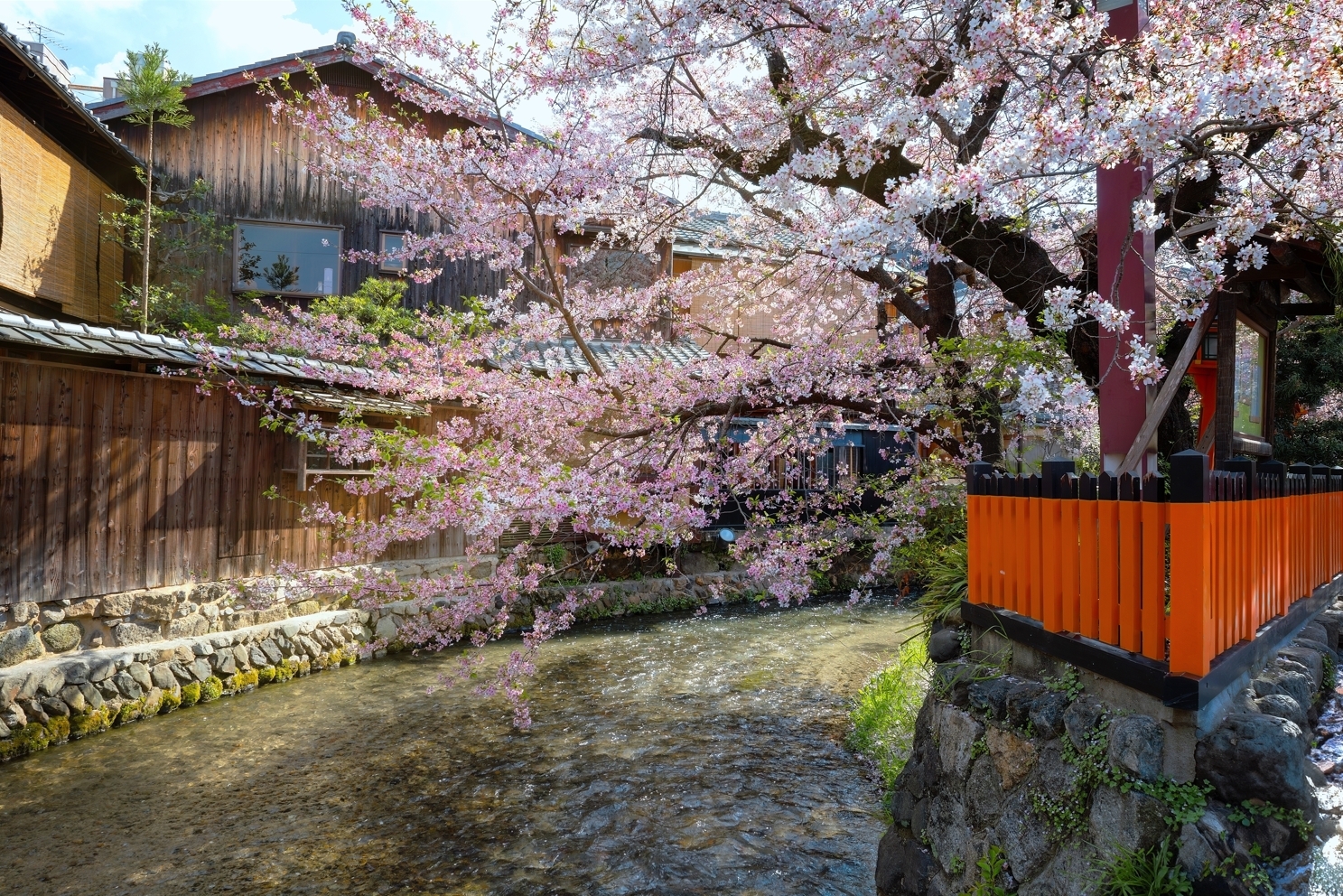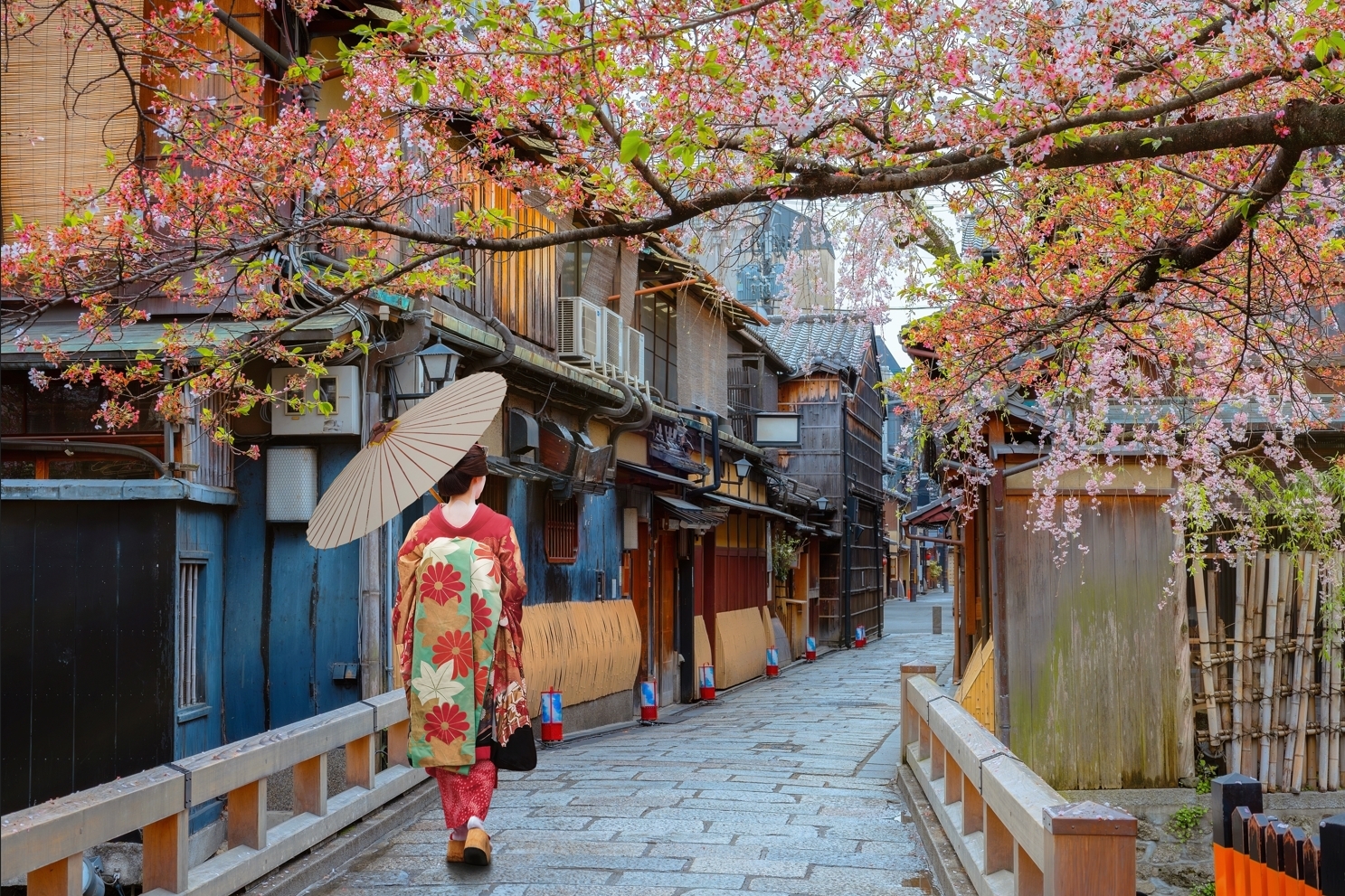
 Gion Walking Tour with Guide
Gion Walking Tour with Guide
The walking tour lasts about 60 minutes, just enough to learn what you may be wondering about the mysterious world of geisha and the historic Geisha neighborhoods. Whether it is the geisha kimono, the training of the apprentice geisha or the flaws of the movie “Memoirs of Geisha” you will learn a lot. Walking in the historic Gion geisha district will undoubtedly give you a feeling of time travel where every street has many stories to tell.

Gion Kyoto geisha district is Japan's most popular geisha neighborhood.
In Gion you can find traditional old buildings with lantern-lit yards and upscale town-house-style restaurants that look like a scene from a fairy tale.
Most travelers go to Gion in the evening to see the geishas and have dinner in the neighboring restaurants.
The historic Gion Kyoto geisha district is located between the Kamo River and the famous Yasaka Shrine covering the right side and left side of the popular Shijo Street. The center of Gion is the intersection of Hanamikoji Street and Shijo Street where you can spot geishas heading to banquets in the early evening. The closest train station is Gion-Shijo (Keihan Line, Exit 6). You can go to Gion from Kyoto Station by taking bus #100 or #206.
In Gion, you will not only see the traditional country houses and perhaps randomly spot geishas, but also find Kenninji Temple, the oldest zen temple with relaxing zen gardens and discover Yasui Konpiragu, a historical shrine with a secret love stone. Hanamikoji Street is where all Gion visitors wander around. Unlike other streets in Kyoto, on this street, there are no electric lines above the ground and the whole area is a historic preservation site.
 Ichiriki Chaya Tea House in Gion Kyoto located on the intersection between Shijo Street and Hanamikoji Street © Kyoto Geisha Show & Experience Gion Maikoya
Ichiriki Chaya Tea House in Gion Kyoto located on the intersection between Shijo Street and Hanamikoji Street © Kyoto Geisha Show & Experience Gion Maikoya
 Kenninji Temple Rock Gardens and the Double Headed Dragon Ceiling © Kyoto Geisha Show & Experience Gion Maikoya
Kenninji Temple Rock Gardens and the Double Headed Dragon Ceiling © Kyoto Geisha Show & Experience Gion Maikoya
Right across from the Kenninji Temple you will see a couple of old and modern buildings. The biggest one is called Gion Corner. There you can enjoy seven types of traditional performing arts: kyo-mai (Kyoto style dance) performed by maiko, tea ceremony, flower arrangement, koto (Japanese harp) music, Gagaku (Japanese classical music), Kyogen (traditional Japanese comic theatre), and Bunraku (traditional Japanese puppet theatre). Here you can watch Japanese traditional arts in ‘digest’ form all on one stage.
If you walk towards the hill for 100 meters you will see a tiny street heading to the Yasui Konpiragu Shrine. The original Yasui Konpiragu Shrine was established more than 800 years ago for the emperor Sutoku and moved to Gion about 400 hundred years ago. Emperor shutoku and the deity of ships and sailors are enshrined in this shrine.
In the middle of the Shrine you will see a huge stone covered small pieces of white paper. That stone has the shape of EMA which you see in all shinto shrines. The legend goes that if you write your wishes on a wooden ema piece and then crawl under this huge stone, you break the bad relationship and start good relationships.
 Yasaka no Pagoda Gion- Hokanji Temple © Kyoto Geisha Show & Experience Gion Maikoya
Yasaka no Pagoda Gion- Hokanji Temple © Kyoto Geisha Show & Experience Gion Maikoya
 Geisha walking in Miyagawacho. Miyagawacho is only 5-minute walk from Gion © Kyoto Geisha Show & Experience Gion Maikoya
Geisha walking in Miyagawacho. Miyagawacho is only 5-minute walk from Gion © Kyoto Geisha Show & Experience Gion Maikoya
 Beatiful Street View of Gion Shirakawa
Beatiful Street View of Gion Shirakawa
 Gion Tatsumi Bridge in Shirakawa Dori © Sean Pavone
Gion Tatsumi Bridge in Shirakawa Dori © Sean PavoneYasaka Shrine (previously known as Gion shrine) is one of the neighborhood's most popular and iconic destinations. Tucked between the Gion and Higashiyama districts, it attracts countless visitors who pass through both famous areas daily, drawn to its proud lantern lined glory.
Before you leave Kyoto, be sure to pop by Patisserie Gion Sakai, located on Hanamikoji Dori. This charmingly historic building is home to one of the best collections of sweets in the city, including cakes, tarts, meringues, cookies, and pastries. This cozy three-table-room looks out onto the vibrant and scenic scenes of Hanamikoji Dori. It does get popular though, so be prepared to wait a little.
Heading east on Shijo-dori Street is the magnificent Minamiza theater. The theatre hosts a range of theatre performances, but their most iconic ones are kabuki. From the early 17th century, kabuki theatre flourished here in Kyoto, and Minamiza was once one of the city's seven kabuki theaters.
Shijo-dori is one of the main streets running through the city from east to west. Yasaka Shrine, located at the starting point of the east, is the total headquarters of about 2,300 shrines dedicated to Yasaka Shrine nationwide. Gion, known as Gion-sha, was once known as the Gion-sha. It is believed to be founded over 1350 years ago.
After walking on the streets of Gion you can relax at one of the matcha cafes on Shijo Street (Shijo Dori) or check out some souvenir shops. Some most popular gifts are kimono-style hairpins, kokeshi dolls, and Kyoto's famous yatsuhashi sweets.
In 1772 the area received permission from the Tokugawa shogunate to have a special business style. In 1871 Yasaka Shrine which used to be called the Gion Shrine, was recognized as the kanpei-taisha (highest rank government-supported shrines). More teahouses near the shrine were built and many geisha served tea to visitors. In 1881 Gion was separated into two parts, Gion Kobu, and Gion Otsubu. During the Meiji period, there were over 700 teahouses and more than 3000 geiko and maiko inside Gion.
 Geisha Show Miyako Odori © Minamiza Theater
Geisha Show Miyako Odori © Minamiza Theater
Also known as the Gion Festival (祇園祭), or the festival of Yasaka Shrine, the Gion Matsuri is one of, if not the most, famous traditional celebrations in Japan. These days the celebrations get so big that they take over the entire month of the sweltering month of July, filling the streets with music, color food, and a festive atmosphere is at an all-time high.
There are many restaurants and izakayas in Gion. So most people visit Gion to enjoy the traditional kaiseki meals at one of the restaurants in Gion at night. If you can afford, you may be able to arrange a special geisha meeting that includes dinner by Maikoya. Some travelers go to the Kiyomizu Temple at night as certain times of the year there is night illumination. Some of our guests prefer a rooftop bar and go to In the Moon which is my favorite. Regardless, most people end up by the riverside or the Pontocho Bars Street towards the end of the night which is less than a 10-minute walk from the Gion area.
There are plenty of things you can get amused by wandering across Gion. You can visit Kiyomizu Dera, Fushimi Inari Taisha Shrine, or get lost in Shijo-dori. The cultural choice of Gion differs much.
Sitting on the southern edge of the Gion district, Kiyomizudera is one of the city’s most sacred destinations and well worth a trip to Gion just to visit. The temple was founded in 780, and is located on the eastern Otowa Waterfall in the wooded hills, its name - which translates in English to "Pure Water Temple," came from this waterfall. Kiyomizudera offers guests unparalleled views of the surrounding foliage transforming with the passing seasons.
If you want to see the autumn leaves of Kyoto, Kodaiji Temple is highly recommended. Kodaiji Temple is a spot where you can feel the graceful beauty of autumn foliage. It is the second most popular garden in Japan and the first place in Kyoto Prefecture for the autumn season.
Fushimi Inari Taisha Shrine, which is known as "Inari-san", is the head shrine of more than 30,000 shrines nationwide dedicated to Inari. It was built in 711, and it is said that there are benefits of business prosperity and home security, and it is full of many worshipers throughout the year.
Fushimi Inari is only a 10-minute train ride from the Gion area. Just go to the Gion Shijo Station and take the Keihan Train. (map) website: inari.jp . The area has no gates, you can visit it 24 hours a day but it gets spooky at night.
The geisha are human beings, they are not objects. You have to respect the privacy of the geisha. You have to understand that you endanger yourself and the geisha on the narrow streets of Gion when you come too close. You have to understand that geishas are likely on their way to work and they should not be late. You also have to understand that the geisha may be accompanied by their private client whose privacy must be respected.
Martin, J. H., & Martin, P. G. (2012). Kyoto a Cultural Guide: Revised Edition. Tuttle Publishing.
Gion Manner Retrieved from https://kyoto.travel/en/info/manner.html
Downer, L. (2003). Geisha of Gion-A memoir of Mineko Iwasaki.
Coronavirus and Geisha in Kyoto Retrieved from https://mai-ko.com/travel/culture-in-japan/geisha/coronavirus-in-japan-how-kyotos-geisha-are-dealing-with-it/
Ookini Zaidan Geisha Association https://www.ookinizaidan.com/
This is the Gion area map that shows the beginning point of where most people start their walking tour.
This is the Gion Map of our Geisha Museum and Geisha Show Venue
BACK TO Geisha Experience Reservation Page
The geisha are human beings, they are not objects. You have to respect the privacy of the geisha. You have to understand that you endanger yourself and the geisha in the narrow streets of Gion when you come too close. You have to understand that geisha’s are likely on their way to work and they should not be late.
We are KIMONO TEA CEREMONY MAIKOYA GION KIYOMIZU. All of our guides speak fluent English and know how to make you feel at ease by always being patient and smiling constantly. We also provide handouts in different languages in case you have limited language skills. By participating in this tour you will have a local “friend” showing you around rather than being dragged to routine places by a stranger.
We know that travelers neither want a history lecture nor a fast facts trivia. They just want to feel like a local and learn the Japanese view of Geisha and Gion and history. Our guests also often ask us about the souvenir shops, restrooms, hidden gems, transportation to their next stop and local favorite restaurants. So we prepared the perfect package tour with the best price that will make your trip to Japan extra rewarding.
Experience the enchanting world of geishas in Kyoto at Geisha Show & Experience GION MAIKOYA, located in the heart of Gion, just steps from Hanamikoji Street. Our historic, government-protected teahouse, complete with a beautiful Japanese garden, offers authentic geisha encounters reminiscent of the 1800s, providing a unique glimpse into this captivating tradition. Maikoya offers a variety of immersive cultural experiences, including captivating geisha shows, elegant geisha tea ceremonies, unforgettable geisha dinner shows, and insightful private Gion tours exploring the history of geiko and maiko. Conveniently located near popular Higashiyama attractions like Kiyomizu-dera Temple, Yasaka Shrine, and Sannenzaka, Maikoya is the perfect destination for those seeking an enriching cultural experience. Whether you're looking for geisha tickets, want to learn more about geisha in Kyoto, or simply wish to experience the atmosphere of a traditional geisha tea house in Gion, Maikoya provides an unparalleled opportunity to connect with Japanese culture.
ADDRESS ( google map ): 100, Rokurocho, Matsubara-dori Yamatooji Higashiiru, Higashiyama-ku, Kyoto, Japan
email: gion@maikoya.com